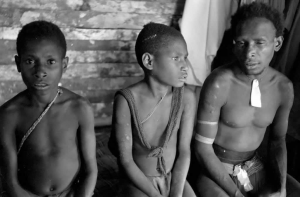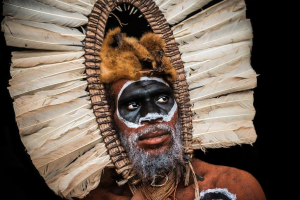(Boylove Documentary Sourcebook) - The "Bau a" Ceremonial Hunting Lodge of the Kaluli People of Papua New Guinea

From "The Bau a Ceremonial Hunting Lodge: An Alternative to Initiation" by Edward L. Schieffelin, in Rituals of Manhood: Male Initiation in Papua New Guinea, edited by Gilbert H. Herdt (New Brunswick, New Jersey: Transaction Publishers, 1998), originally published in 1982 by University of California Press.
Note: The following information relies on firsthand accounts given by people who witnessed the practice in question before it was discontinued.
The bau a itself was an oval building constructed on the ground, in which the membership performed hunting magic and slept for part of the period of their ritual seclusion. The membership ranged from boys of eight or nine years old to bachelors of around twenty-eight. The period of seclusion was about fifteen months. The major criterion for admission, apart from being able to trace some kinship connection to the sponsoring community, was that the individual had never been sexually involved with a woman. The major activity of the bau a, to which most of the rituals pertained and to which all other benefits were in one way or another related, was hunting. The game, principally marsupials of moderate size, was smoked and accumulated in a smoking rack in the bau a in preparation for a large-scale distribution at the climactic ceremony that marked the young men’s coming out of seclusion.
[...]
In conversing about the bau a, my informants’ eyes would shine; their voices would become excited or drop to low, mysterious whispers. Clearly they felt their experiences in the bau a were among the high points of their lives.
A bau a was believed to promote the growth of the young boys (about ten to fourteen years old) and to induce strength and attractively light skin color for the youths and bachelors. It was also believed to ward off sickness and death by quieting the appetites of witches in the surrounding communities. In addition, it led to a general suspension of hostilities and revenge killings among longhouse communities during the time it was in session. Finally, it represented a special relationship between men and the mɛmul spirits of Mount Bosavi.
[...]
The growth of young boys who were around the age of puberty was encouraged specifically by pederastic homosexual intercourse with some of the older bachelors. Kaluli believe that girls attain full maturity as women by natural growth but that boys cannot do so without being given a “boost,” as it were, by the semen of older men. This pederasty was considered a major male secret vis-à-vis the women, and it was generally regarded with embarrassment and lascivious humor among the men themselves. Homosexual intercourse for boys also took place in everyday life beyond the bau a context whenever a boy reached the age of about ten or eleven. At that time, his father would choose a suitable partner to inseminate him, and the two would meet privately in the forest or a garden house for intercourse over a period of months or years. Less frequently a boy might choose his own inseminator, although this was risky: if the man was a witch, his semen would turn the boy into one too. In the bau a, boys were inseminated “openly” (that is, they were inseminated by their homosexual partner after lights out in the close, crowded, smoky darkness of the bau a while the rest of the exhausted hunters were thought to be asleep). A few of the bachelors came to the bau a specifically to act as inseminators, and fathers sometimes assigned their sons to one or the other of them. Other lads chose their own inseminators from among the older bachelors (or bachelors chose them) and formed specific liaisons for a while. Side by side with the serious business of hunting, pederastic intercourse was a marked feature of the bau a which men chuckled over self-consciously in reminiscence.

See also
- Etoro
- Adult friend (dictionary)
- Age of attraction (dictionary)
- Boylove
- Loved boy (dictionary)
- Minor-attracted person (dictionary)
- Pedophilia
- Young friend (dictionary)